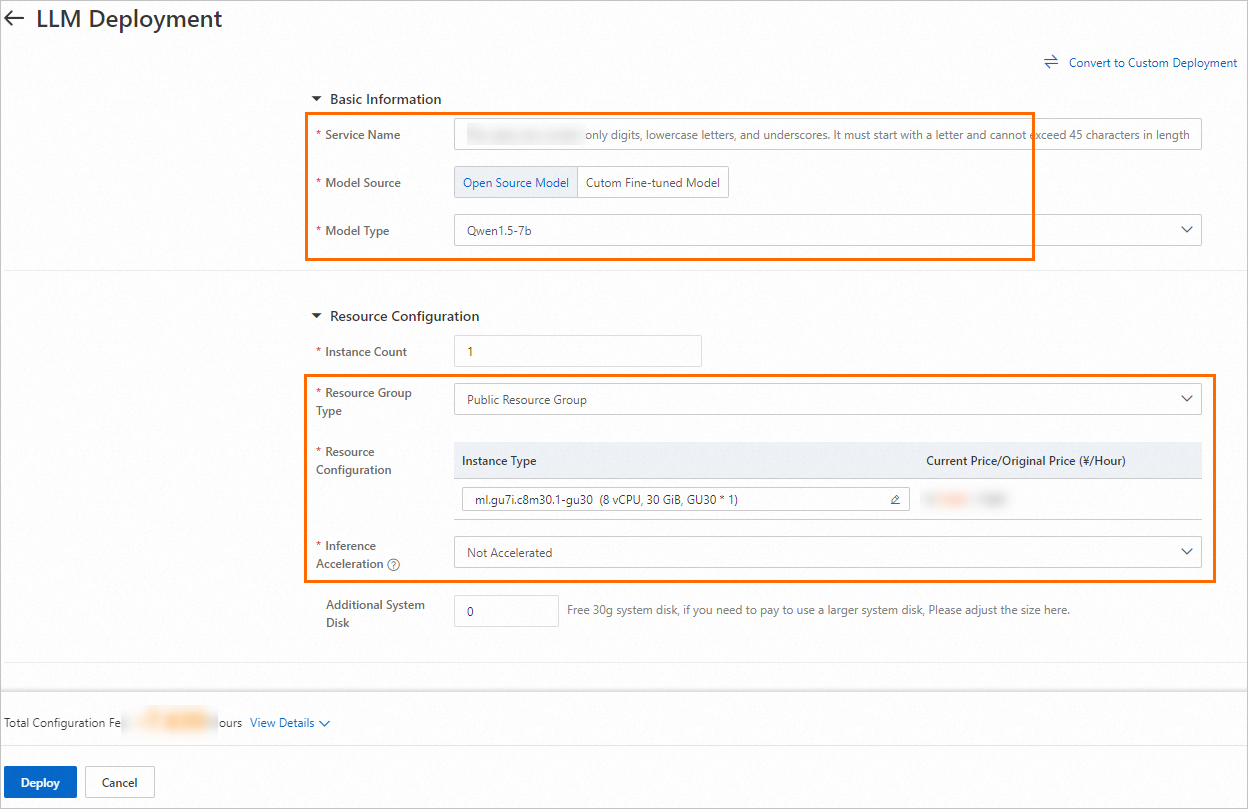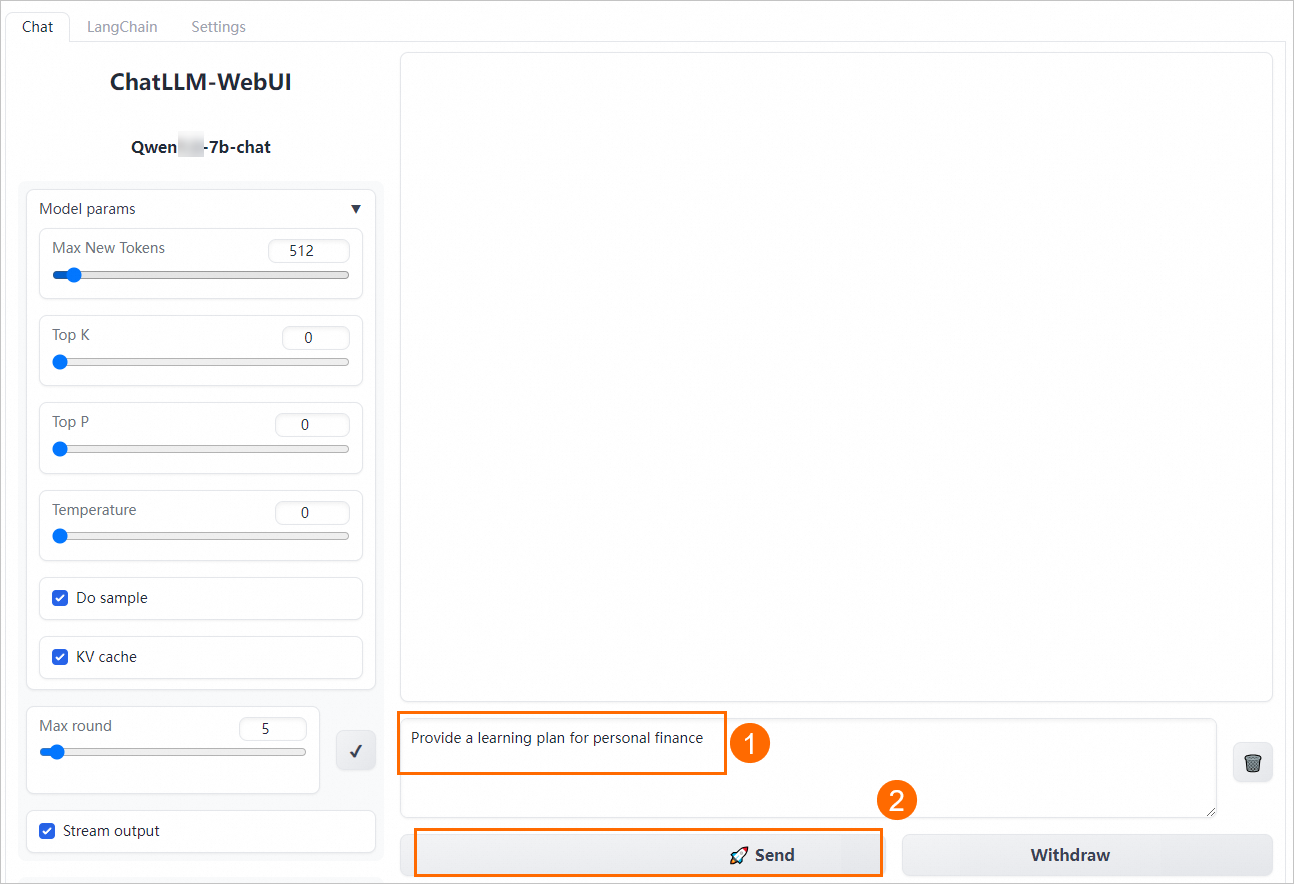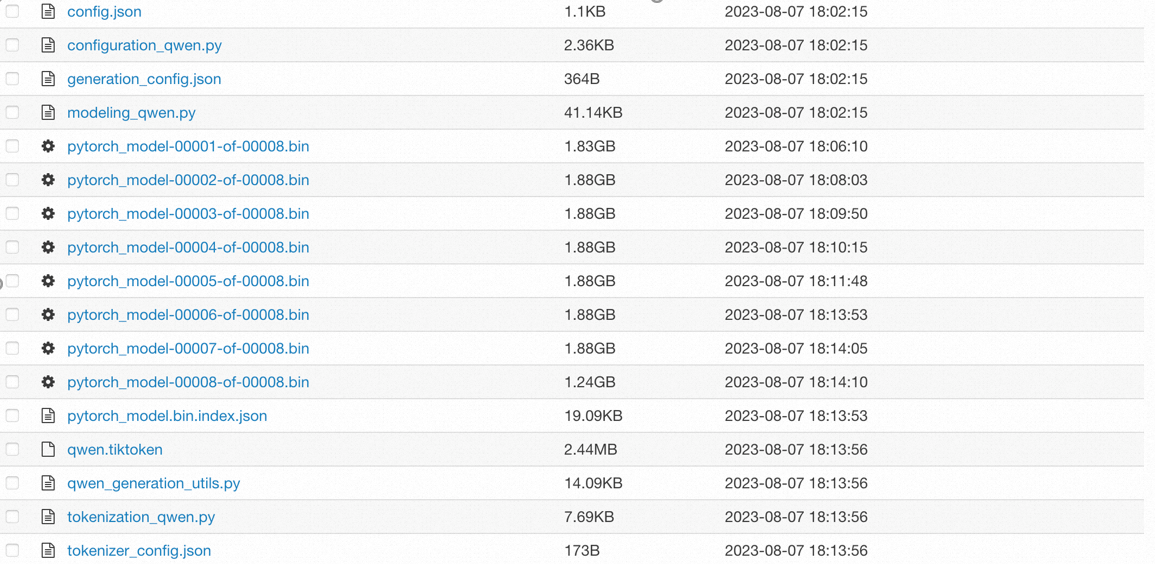Platform for AI (PAI) のElastic Algorithm Service (EAS) は、オンライン推論シナリオのオンラインモデルサービスであり、LLMの自動展開と適用のためのワンクリックソリューションを提供します。EASを使用すると、複数のオープンソースLLMアプリケーションを効率的にデプロイでき、標準デプロイ、BladeLLMベースの高速デプロイ、vLLMベースの高速デプロイの展開方法をサポートします。 BladeLLMおよびvLLMベースの高速展開により、高い同時実行性と低いレイテンシが保証されます。 このトピックでは、EASおよびFAQでLLMを展開して呼び出す方法について説明します。
前提条件
PAIが有効化され、デフォルトのワークスペースが作成されます。 詳細については、「PAIの有効化とデフォルトワークスペースの作成」をご参照ください。
Resource Access Management (RAM) ユーザーを使用してモデルを展開する場合は、RAMユーザーにEASを使用する権限があることを確認します。 詳細については、「EASを使用するために必要な権限の付与」をご参照ください。
EASサービスの展開
Elastic Algorithm Service (EAS) ページに移動します。
PAIコンソールにログインします。
左側のナビゲーションペインで、[ワークスペース] をクリックします。 [ワークスペース] ページで、モデルを配置するワークスペースの名前をクリックします。
左側のナビゲーションウィンドウで、[モデル展開] > [Elastic Algorithm Service (EAS)] を選択して、[Elastic Algorithm Service (EAS)] ページに移動します。

[Elastic Algorithm Service (EAS)] ページで、[サービスのデプロイ] をクリックします。 [サービスのデプロイ] ページの [シナリオベースのモデルのデプロイ] セクションで、[LLMデプロイ] を選択します。
[LLMデプロイ] ページで、次の表に示すパラメーターを設定します。 他のパラメーターにはデフォルト値を使用します。
パラメーター
説明
基本情報
サービス名
サービスの名前を指定します。 例: llm_demo001
バージョン
このパラメーターをオープンソースモデルのクイックデプロイに設定します。
モデルタイプ
このパラメーターをqwen2.5-7b-instructionに設定します。 EASは、DeepSeek-R1、Qwen2-VL、Meta-Llama-3.2-1Bなどのビジネス要件を満たすさまざまなモデルタイプを提供します。
デプロイ方法
このパラメーターを [標準配置] に設定します。 加速フレームワークを使用しないでください。
リソースの配置
リソースタイプ
このパラメーターを [Public Resources] に設定します。
デプロイリソース
モデルタイプを選択すると、システムは自動的に適切なインスタンスタイプを推奨します。

[デプロイ] をクリックします。 モデルの展開には約5分かかります。
WebUIを使用した推論の実行
デプロイされたサービスを見つけ、[サービスタイプ] 列の [Webアプリの表示] をクリックします。

WebUIページで推論パフォーマンスをテストします。
入力テキストボックスに文を入力し、[送信] をクリックして会話を開始します。 サンプル入力:
パーソナルファイナンスの学習プランを提供します。
よくある質問
別のオープンソースLLMに切り替えるにはどうすればよいですか?
EASは次のオープンソースLLMを提供します: DeepSeek-R1、ラマ、UI-TARS、QVQ、Gemma2、およびBaichuan2。 これらのモデルを切り替えるには、次の手順を実行します。
[Elastic Algorithm Service (EAS)] ページで、更新するサービスを見つけ、[操作] 列の [更新] をクリックします。
[LLMデプロイ] ページで、[モデルタイプ] パラメーターを目的のオープンソースLLMに設定します。[デプロイリソース] パラメーターの値が自動的に更新されます。
[Update] をクリックします。
推論サービスの同時実行性を改善し、待ち時間を短縮するにはどうすればよいですか。
EASはBladeLLMとvLLMを提供します。これらは、高い同時実行性と低いレイテンシを確保するために使用できる推論アクセラレーションエンジンです。 推論アクセラレーションエンジンを使用するには、次の手順を実行します。
Elastic Algorithm Service (EAS) ページで、更新するサービスを見つけ、[操作] 列の [更新] をクリックします。
[LLMデプロイ] ページの [基本情報] セクションで、[デプロイ方法] パラメーターを [デプロイの加速] に設定し、[BladeLLM] または [vLLM] を選択します。
[Update] をクリックします。
LLMのデプロイ中に、VersionパラメーターをHigh-performance Deploymentに設定することもできます。 ハイパフォーマンス展開とは、PAIが開発したBladeLLMエンジンに基づく高速展開を指します。 詳細については、「BladeLLMの使用を開始する」をご参照ください。
カスタムモデルをマウントするにはどうすればよいですか?
LLM展開中にバージョンパラメーターをハイパフォーマンス展開に設定すると、カスタムモデルをマウントできます。 オープンソース、微調整、および量子化バージョンを含む、QwenおよびLlamaのテキストモデルのみを展開できます。 この例では、Object Storage Service (OSS) を使用してカスタムモデルをマウントします。
モデルと関連する設定ファイルをOSSバケットにアップロードします。 バケットの作成方法とオブジェクトのアップロード方法については、「バケットの作成」と「オブジェクトのアップロード」をご参照ください。
次の図は、準備する必要があるモデルファイルのサンプルを示しています。

config.jsonファイルをアップロードする必要があります。 Huggingfaceモデル形式に基づいてconfig.jsonファイルを設定する必要があります。
サンプルファイルの詳細については、「config.json」をご参照ください。
Elastic Algorithm Service (EAS) ページで、更新するサービスを見つけ、[操作] 列の [更新] をクリックします。
[LLMデプロイ] ページで、次のパラメーターを指定し、[更新] をクリックします。
パラメーター
説明
基本情報
バージョン
このパラメーターをHigh-performance Deploymentに設定します。
イメージバージョン
このパラメーターをblade-llm:0.9.0に設定します。
モデル設定
このパラメーターを [カスタムモデル] に設定し、[OSS] をクリックします。 カスタムモデルが保存されているOSSパスを選択します。
リソースの配置
デプロイリソース
インスタンスタイプを選択します。 詳細については、「制限事項」をご参照ください。
API操作を呼び出して推論を実行するにはどうすればよいですか?
呼び出し方法は、展開モードによって異なります。 デプロイメントオプションに基づいて適切な呼び出し方法を選択できます。
標準展開
サービスエンドポイントとトークンを取得します。
EASに移動し、ワークスペースを選択し、EASにアクセスします。
目的のサービスの名前をクリックして、詳細ページを表示します。
[基本情報] セクションで、[通話情報の表示] をクリックします。 [パブリックエンドポイントの呼び出し] タブで、サービストークンとエンドポイントを取得します。
API操作を呼び出して推論を実行するには、次のいずれかの方法を使用します。
HTTPの使用
非ストリーミングモード
クライアントは、curlコマンドが実行されると、次のタイプの標準HTTPリクエストを送信します。
ストリング要求
curl $host -H 'Authorization: $authorization' --data-binary @chatllm_data.txt -v$authorizationをサービストークンに置き換えます。 $hostをサービスエンドポイントに置き換えます。 chatllm_data.txtファイルは、プロンプトを含むプレーンテキストファイルです。たとえば、
カナダの首都は何ですか?構造化リクエスト
curl $host -H 'Authorization: $authorization' -H "Content-type: application/json" --data-binary @chatllm_data.json -v -H "Connection: close"chatllm_data.jsonファイルを使用して推論パラメーターを設定します。 次のサンプルコードは、chatllm_data.jsonファイルの形式例を示しています。
{ "max_new_tokens": 4096, "use_stream_chat": false, "prompt": "What is the capital of Canada?", "system_prompt": "Act like you are a knowledgeable assistant who can provide information on geography and related topics.", "history": [ [ "Can you tell me what's the capital of France?", "The capital of France is Paris." ] ], "temperature": 0.8, "top_k": 10, "top_p": 0.8, "do_sample": true, "use_cache": true }次の表に、上記のコードのパラメーターを示します。 ビジネス要件に基づいてパラメーターを設定します。
パラメーター
説明
デフォルト値
max_new_tokens
出力トークンの最大数。
2048
use_stream_chat
ストリーミングモードで出力トークンを返すかどうかを指定します。
true
プロンプト
ユーザープロンプト。
""
system_prompt
システムプロンプト。
""
history
対話の歴史。 値はList[Tuple(str, str)] 形式です。
[()]
temperature
モデル出力のランダム性。 より大きな値は、より高いランダム性を指定する。 値0は、固定出力を指定する。 値はFloat型で、0から1の範囲です。
0.95
top_k
生成された結果から選択された出力の数。
30
top_p
生成された結果から選択された出力の確率しきい値。 値はFloat型で、0から1の範囲です。
0.8
do_sample
出力サンプリングを有効にするかどうかを指定します。
true
use_cache
KVキャッシュを有効にするかどうかを指定します。
true
Pythonリクエストパッケージに基づいてクライアントを実装することもできます。
-- promptパラメーターを使用して、python xxx.py -- prompt "What is the capital of Canada?などのリクエストコンテンツを指定できます。import argparse import json from typing import Iterable, List import requests def post_http_request(prompt: str, system_prompt: str, history: list, host: str, authorization: str, max_new_tokens: int = 2048, temperature: float = 0.95, top_k: int = 1, top_p: float = 0.8, langchain: bool = False, use_stream_chat: bool = False) -> requests.Response: headers = { "User-Agent": "Test Client", "Authorization": f"{authorization}" } if not history: history = [ ( "San Francisco is a", "city located in the state of California in the United States. \ It is known for its iconic landmarks, such as the Golden Gate Bridge \ and Alcatraz Island, as well as its vibrant culture, diverse population, \ and tech industry. The city is also home to many famous companies and \ startups, including Google, Apple, and Twitter." ) ] pload = { "prompt": prompt, "system_prompt": system_prompt, "top_k": top_k, "top_p": top_p, "temperature": temperature, "max_new_tokens": max_new_tokens, "use_stream_chat": use_stream_chat, "history": history } if langchain: pload["langchain"] = langchain response = requests.post(host, headers=headers, json=pload, stream=use_stream_chat) return response def get_response(response: requests.Response) -> List[str]: data = json.loads(response.content) output = data["response"] history = data["history"] return output, history if __name__ == "__main__": parser = argparse.ArgumentParser() parser.add_argument("--top-k", type=int, default=4) parser.add_argument("--top-p", type=float, default=0.8) parser.add_argument("--max-new-tokens", type=int, default=2048) parser.add_argument("--temperature", type=float, default=0.95) parser.add_argument("--prompt", type=str, default="How can I get there?") parser.add_argument("--langchain", action="store_true") args = parser.parse_args() prompt = args.prompt top_k = args.top_k top_p = args.top_p use_stream_chat = False temperature = args.temperature langchain = args.langchain max_new_tokens = args.max_new_tokens host = "<Public endpoint of the EAS service>" authorization = "<Public token of the EAS service>" print(f"Prompt: {prompt!r}\n", flush=True) # System prompts can be included in the requests. system_prompt = "Act like you are programmer with \ 5+ years of experience." # Dialogue history can be included in the client request. The client manages the dialogue history to implement multi-round dialogues. In most cases, information from the previous round of dialogue is used. The information is in the List[Tuple(str, str)] format. history = [] response = post_http_request( prompt, system_prompt, history, host, authorization, max_new_tokens, temperature, top_k, top_p, langchain=langchain, use_stream_chat=use_stream_chat) output, history = get_response(response) print(f" --- output: {output} \n --- history: {history}", flush=True) # The server returns a JSON response that includes the inference result and dialogue history. def get_response(response: requests.Response) -> List[str]: data = json.loads(response.content) output = data["response"] history = data["history"] return output, history次のパラメータに注意してください。
hostパラメーターをサービスエンドポイントに設定します。
authorizationパラメーターをサービストークンに設定します。
ストリーミングモード
ストリーミングモードでは、HTTP SSEメソッドが使用されます。
-- promptパラメーターを使用して、python xxx.py -- prompt "What is the capital of Canada?などのリクエストコンテンツを指定できます。import argparse import json from typing import Iterable, List import requests def clear_line(n: int = 1) -> None: LINE_UP = '\033[1A' LINE_CLEAR = '\x1b[2K' for _ in range(n): print(LINE_UP, end=LINE_CLEAR, flush=True) def post_http_request(prompt: str, system_prompt: str, history: list, host: str, authorization: str, max_new_tokens: int = 2048, temperature: float = 0.95, top_k: int = 1, top_p: float = 0.8, langchain: bool = False, use_stream_chat: bool = False) -> requests.Response: headers = { "User-Agent": "Test Client", "Authorization": f"{authorization}" } if not history: history = [ ( "San Francisco is a", "city located in the state of California in the United States. \ It is known for its iconic landmarks, such as the Golden Gate Bridge \ and Alcatraz Island, as well as its vibrant culture, diverse population, \ and tech industry. The city is also home to many famous companies and \ startups, including Google, Apple, and Twitter." ) ] pload = { "prompt": prompt, "system_prompt": system_prompt, "top_k": top_k, "top_p": top_p, "temperature": temperature, "max_new_tokens": max_new_tokens, "use_stream_chat": use_stream_chat, "history": history } if langchain: pload["langchain"] = langchain response = requests.post(host, headers=headers, json=pload, stream=use_stream_chat) return response def get_streaming_response(response: requests.Response) -> Iterable[List[str]]: for chunk in response.iter_lines(chunk_size=8192, decode_unicode=False, delimiter=b"\0"): if chunk: data = json.loads(chunk.decode("utf-8")) output = data["response"] history = data["history"] yield output, history if __name__ == "__main__": parser = argparse.ArgumentParser() parser.add_argument("--top-k", type=int, default=4) parser.add_argument("--top-p", type=float, default=0.8) parser.add_argument("--max-new-tokens", type=int, default=2048) parser.add_argument("--temperature", type=float, default=0.95) parser.add_argument("--prompt", type=str, default="How can I get there?") parser.add_argument("--langchain", action="store_true") args = parser.parse_args() prompt = args.prompt top_k = args.top_k top_p = args.top_p use_stream_chat = True temperature = args.temperature langchain = args.langchain max_new_tokens = args.max_new_tokens host = "" authorization = "" print(f"Prompt: {prompt!r}\n", flush=True) system_prompt = "Act like you are programmer with \ 5+ years of experience." history = [] response = post_http_request( prompt, system_prompt, history, host, authorization, max_new_tokens, temperature, top_k, top_p, langchain=langchain, use_stream_chat=use_stream_chat) for h, history in get_streaming_response(response): print( f" --- stream line: {h} \n --- history: {history}", flush=True)次のパラメータに注意してください。
hostパラメーターをサービスエンドポイントに設定します。
authorizationパラメーターをサービストークンに設定します。
WebSocketの使用
WebSocketプロトコルは、ダイアログ履歴を効率的に処理できます。 WebSocketメソッドを使用してサービスに接続し、1回以上のダイアログを実行できます。 サンプルコード:
import os import time import json import struct from multiprocessing import Process import websocket round = 5 questions = 0 def on_message_1(ws, message): if message == "<EOS>": print('pid-{} timestamp-({}) receives end message: {}'.format(os.getpid(), time.time(), message), flush=True) ws.send(struct.pack('!H', 1000), websocket.ABNF.OPCODE_CLOSE) else: print("{}".format(time.time())) print('pid-{} timestamp-({}) --- message received: {}'.format(os.getpid(), time.time(), message), flush=True) def on_message_2(ws, message): global questions print('pid-{} --- message received: {}'.format(os.getpid(), message)) # end the client-side streaming if message == "<EOS>": questions = questions + 1 if questions == 5: ws.send(struct.pack('!H', 1000), websocket.ABNF.OPCODE_CLOSE) def on_message_3(ws, message): print('pid-{} --- message received: {}'.format(os.getpid(), message)) # end the client-side streaming ws.send(struct.pack('!H', 1000), websocket.ABNF.OPCODE_CLOSE) def on_error(ws, error): print('error happened: ', str(error)) def on_close(ws, a, b): print("### closed ###", a, b) def on_pong(ws, pong): print('pong:', pong) # stream chat validation test def on_open_1(ws): print('Opening Websocket connection to the server ... ') params_dict = {} params_dict['prompt'] = """Show me a golang code example: """ params_dict['temperature'] = 0.9 params_dict['top_p'] = 0.1 params_dict['top_k'] = 30 params_dict['max_new_tokens'] = 2048 params_dict['do_sample'] = True raw_req = json.dumps(params_dict, ensure_ascii=False).encode('utf8') # raw_req = f"""To open a Websocket connection to the server: """ ws.send(raw_req) # end the client-side streaming # multi-round query validation test def on_open_2(ws): global round print('Opening Websocket connection to the server ... ') params_dict = {"max_new_tokens": 6144} params_dict['temperature'] = 0.9 params_dict['top_p'] = 0.1 params_dict['top_k'] = 30 params_dict['use_stream_chat'] = True params_dict['prompt'] = "Hello!" params_dict = { "system_prompt": "Act like you are programmer with 5+ years of experience." } raw_req = json.dumps(params_dict, ensure_ascii=False).encode('utf8') ws.send(raw_req) params_dict['prompt'] = "Please write a sorting algorithm in Python." raw_req = json.dumps(params_dict, ensure_ascii=False).encode('utf8') ws.send(raw_req) params_dict['prompt'] = "Please convert the programming language to Java." raw_req = json.dumps(params_dict, ensure_ascii=False).encode('utf8') ws.send(raw_req) params_dict['prompt'] = "Please introduce yourself." raw_req = json.dumps(params_dict, ensure_ascii=False).encode('utf8') ws.send(raw_req) params_dict['prompt'] = "Please summarize the dialogue above." raw_req = json.dumps(params_dict, ensure_ascii=False).encode('utf8') ws.send(raw_req) # Langchain validation test. def on_open_3(ws): global round print('Opening Websocket connection to the server ... ') params_dict = {} # params_dict['prompt'] = """To open a Websocket connection to the server: """ params_dict['prompt'] = """Can you tell me what's the MNN?""" params_dict['temperature'] = 0.9 params_dict['top_p'] = 0.1 params_dict['top_k'] = 30 params_dict['max_new_tokens'] = 2048 params_dict['use_stream_chat'] = False params_dict['langchain'] = True raw_req = json.dumps(params_dict, ensure_ascii=False).encode('utf8') ws.send(raw_req) authorization = "" host = "ws://" + "" def single_call(on_open_func, on_message_func, on_clonse_func=on_close): ws = websocket.WebSocketApp( host, on_open=on_open_func, on_message=on_message_func, on_error=on_error, on_pong=on_pong, on_close=on_clonse_func, header=[ 'Authorization: ' + authorization], ) # setup ping interval to keep long connection. ws.run_forever(ping_interval=2) if __name__ == "__main__": for i in range(5): p1 = Process(target=single_call, args=(on_open_1, on_message_1)) p2 = Process(target=single_call, args=(on_open_2, on_message_2)) p3 = Process(target=single_call, args=(on_open_3, on_message_3)) p1.start() p2.start() p3.start() p1.join() p2.join() p3.join()次のパラメータに注意してください。
authorizationパラメーターをサービストークンに設定します。
hostパラメーターをサービスエンドポイントに設定します。 エンドポイントのhttpプレフィックスをwsに置き換えます。
use_stream_chatパラメーターを使用して、クライアントがストリーミングモードで出力を生成するかどうかを指定します。 デフォルト値は True です。
マルチラウンドダイアログを実装するには、上記のコードのon_open_2関数を参照してください。
BladeLLMベースの高速デプロイ
サービスのエンドポイントとトークンを表示します。
[Elastic Algorithm Service (EAS)] ページで、目的のサービスを見つけ、[サービスタイプ] 列の [呼び出し方法] をクリックします。
[呼び出し方法] ダイアログボックスで、サービスのエンドポイントとトークンを表示できます。
ターミナルで次のコードを実行して、サービスを呼び出し、ストリーミングモードで生成されたテキストを取得します。
# Call EAS service curl -X POST \ -H "Content-Type: application/json" \ -H "Authorization: AUTH_TOKEN_FOR_EAS" \ -d '{"prompt":"What is the capital of Canada?", "stream":"true"}' \ <service_url>/v1/completions次のパラメータに注意してください。
権限付与: サービスのトークン。
<service_url>: サービスのエンドポイント。
レスポンス例:
data: {"id":"91f9a28a-f949-40fb-b720-08ceeeb2****","choices":[{"finish_reason":"","index":0,"logprobs":null,"text":" The"}],"object":"text_completion","usage":{"prompt_tokens":7,"completion_tokens":1,"total_tokens":8},"error_info":null} data: {"id":"91f9a28a-f949-40fb-b720-08ceeeb2****","choices":[{"finish_reason":"","index":0,"logprobs":null,"text":" capital"}],"object":"text_completion","usage":{"prompt_tokens":7,"completion_tokens":2,"total_tokens":9},"error_info":null} data: {"id":"91f9a28a-f949-40fb-b720-08ceeeb2****","choices":[{"finish_reason":"","index":0,"logprobs":null,"text":" of"}],"object":"text_completion","usage":{"prompt_tokens":7,"completion_tokens":3,"total_tokens":10},"error_info":null} data: {"id":"91f9a28a-f949-40fb-b720-08ceeeb2****","choices":[{"finish_reason":"","index":0,"logprobs":null,"text":" Canada"}],"object":"text_completion","usage":{"prompt_tokens":7,"completion_tokens":4,"total_tokens":11},"error_info":null} data: {"id":"91f9a28a-f949-40fb-b720-08ceeeb2****","choices":[{"finish_reason":"","index":0,"logprobs":null,"text":" is"}],"object":"text_completion","usage":{"prompt_tokens":7,"completion_tokens":5,"total_tokens":12},"error_info":null} data: {"id":"91f9a28a-f949-40fb-b720-08ceeeb2****","choices":[{"finish_reason":"","index":0,"logprobs":null,"text":" Ottawa"}],"object":"text_completion","usage":{"prompt_tokens":7,"completion_tokens":6,"total_tokens":13},"error_info":null} data: {"id":"91f9a28a-f949-40fb-b720-08ceeeb2****","choices":[{"finish_reason":"","index":0,"logprobs":null,"text":"."}],"object":"text_completion","usage":{"prompt_tokens":7,"completion_tokens":7,"total_tokens":14},"error_info":null} data: {"id":"91f9a28a-f949-40fb-b720-08ceeeb2****","choices":[{"finish_reason":"stop","index":0,"logprobs":null,"text":""}],"object":"text_completion","usage":{"prompt_tokens":7,"completion_tokens":8,"total_tokens":15},"error_info":null} data: [DONE]
vLLMベースの高速デプロイ
サービスアクセスアドレスとトークンを表示するには:
[モデルオンラインサービス (EAS)] ページで、目的のサービスの [サービス方法] 列をクリックし、[通話情報] を選択します。
[呼び出し情報] ダイアログボックスで、サービスアクセスアドレスとトークンをメモします。
ターミナルで、次のコードを実行してサービスを呼び出します。
Python
from openai import OpenAI ##### API configuration ##### openai_api_key = "<EAS API KEY>" openai_api_base = "<EAS API Endpoint>/v1" client = OpenAI( api_key=openai_api_key, base_url=openai_api_base, ) models = client.models.list() model = models.data[0].id print(model) def main(): stream = True chat_completion = client.chat.completions.create( messages=[ { "role": "user", "content": [ { "type": "text", "text": "What is the capital of Canada?", } ], } ], model=model, max_completion_tokens=2048, stream=stream, ) if stream: for chunk in chat_completion: print(chunk.choices[0].delta.content, end="") else: result = chat_completion.choices[0].message.content print(result) if __name__ == "__main__": main()次のパラメータに注意してください。
<EAS API KEY>: このパラメーターを取得したサービストークンに設定します。
<EAS API Endpoint>: このパラメーターを取得したサービスエンドポイントに設定します。
CLI
curl -X POST <service_url>/v1/chat/completions -d '{ "model": "Qwen2.5-7B-Instruct", "messages": [ { "role": "system", "content": [ { "type": "text", "text": "You are a helpful and harmless assistant." } ] }, { "role": "user", "content": "What is the capital of Canada?" } ] }' -H "Content-Type: application/json" -H "Authorization: <your-token>"次のパラメータに注意してください。
<service_url>: このパラメーターを取得したサービスエンドポイントに設定します。
<your-token>: このパラメーターを取得したサービストークンに設定します。
関連ドキュメント
EASの詳細については、「EASの概要」をご参照ください。
WebUIページでLangChainフレームワークを使用すると、APIを使用するときにナレッジベースも使用できます。 ナレッジベースをオンプレミスのベクトルデータベースに保存することをお勧めします。 詳細については、「RAGベースのLLMチャットボット」をご参照ください。
ChatLLM-WebUIのバージョンの詳細については、「ChatLLM WebUIのリリースノート」をご参照ください。